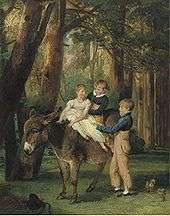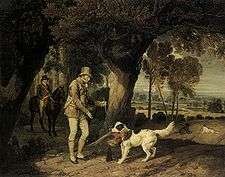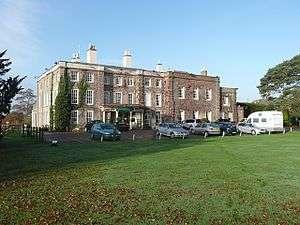Wychnor Hall
| Wychnor Park | |
|---|---|
|
Wychnor Park | |
 | |
| General information | |
| Town or city | Staffordshire |
| Country | England, United Kingdom |
| Coordinates | 52°44′53″N 1°45′38″W / 52.74806°N 1.76056°W |
| Client | The Levett Family |

Wychnor Hall (or Wychnor Park) is Grade II Listed early 18th-century country house near Burton on Trent, Staffordshire. The Hall was formerly owned by the Levett Family, descendants of Theophilus Levett, who was Steward of the city of Lichfield in the early eighteenth century.
The hall has been converted to a Country Club.
History
Wychnor takes its name from the Old English meaning 'village on a bank.' It's earliest spelling was H.wiccenofre. Ofre was the Anglo-Saxon word for "edge or bank". Hwicce was a provence comprising Gloucestershire, Worcestershire and a part of Warwickshire and the people were called Hwiccas or Hwicii. It is thought that some of these people came to settle in Wychnor and so gave their name to the place they settled in.[1]
King James I reportedly stayed at the hall in 1621 and 1624.[2]
The present hall dates from the time of Queen Anne but was much altered and extended in the mid 19th century.[3]
There are a number of curious customs associated with Wychnor, at least one of which was said to have begun with Sir Philip de Somerville, who owned the manor of Wychnor in 1338. A flitch of bacon was kept in the hall [4] that could be claimed by anyone who had been married "for a year and a day without quarrelling or repenting; and that if they were then single, and wished to be married again, the demandant would take the same party before any other in the world." [5] Valid claimants being few and far between, the flitch was replaced by a wooden effigy of same, which continued to hang in the hall for many centuries.[6]
The Levett Family
The house was for many years the home of the Levett family (relations of Levett of Milford Hall).[7][8] The family came from Sussex, arriving in Staffordshire from Cheshire in the early eighteenth century. Through intermarriage with the Floyer family of Hints, Staffordshire, the Levetts of Wychnor claim descent from King Edward III of England through his son Lionel of Antwerp, 1st Duke of Clarence.[9]
The family's wealth largely derived from ownership of coal mines in Staffordshire and Derbyshire, as well as large landholdings and investments in the early Industrial Revolution enterprises associated with inventor Matthew Boulton.[10]
The Levetts also held land at Edial and Curborough (inherited from their Babington ancestors) and elsewhere in Staffordshire.[11][12]
Theophilus Levett was Steward (Town Clerk) of the City of Lichfield 1721–46, and his grandson and namesake was Recorder of Lichfield and High Sheriff of Staffordshire in 1809. Theophilus was named for Theophilus Hastings, 7th Earl of Huntingdon, whose wife the Countess of Huntingdon was Levett's godmother. Theophilus Levett died in 1839. His friend General William Dyott, Aide-de-camp to King George III, attended Levett's simple funeral at Wychnor and noted that Levett "has left great riches to his younger children with the exception of his son Arthur, to whom he has bequeathed £4,000."
Theophilus Levett's son John Levett (landowner, investor and sometime member of the Lunar Society), was Member of Parliament for Lichfield. John Levett was also a friend of long standing to Matthew Boulton, the early inventor, as well as an early investor in Boulton's Soho Manufactory.[13]
Another John Levett was High Sheriff of Staffordshire in 1846.[14]
Theophilus John Levett, grandson of the first Theophilus, was M.P. for Lichfield from 1880 to 1885.

The family had a long association with Samuel Johnson, whom the first Theophilus Levett counted among his friends, and to whom he loaned money, including assuming the mortgage on Johnson's mother's Lichfield home on 31 January 1739, for £80.[15] Johnson frequently wrote to Levett, and later to Levett's son John, pleading for extensions for his late payments.[16] Levett later carried the mortgage as well as other loans to Johnson, who eventually paid them off in 1757.[17]
Theophilus Levett also had a long friendship with David Garrick, an English actor, playwright and friend of Samuel Johnson's, who was also raised in Lichfield.
Many members of the Levett family of Wychnor Hall were Oxford graduates.[18]
Members of the Levett family of Wychnor have intermarried into other county families over the centuries, carrying the name into other family lines.[19][20] The Levett-Prinseps, for instance, descendants of the Levetts of Wychnor, formerly owned Croxall Hall in Derbyshire. The Latin motto on the coat of arms of the Levett-Prinsep family was Non Prodigus Neque Avarus: Neither prodigal nor mean.[21]
The Levetts also had homes in Lichfield as well and several streets in the city are named for them today.[22]
Later history
The Levett family held Wychnor Hall until 1913, when it was sold to Lt.-Col. W.E. Harrison, of a family who had mining interests around Cannock, in the West Midlands.[23] The estate was broken up and sold piecemeal in 1976 and the Hall and its immediate grounds passed through various owners, being converted into the Wychnor Park Country Club after 1981.[24]
References
- ↑ Harrison, Edith (1934). The Story of Wychnor ... Written for the school children of Wychnor. pp. 9–10.
- ↑ A Topographical History of England (1848) Samuel Lewis p. 564 from British History Online
- ↑ Mansions and Country Seats of Staffordshire and Warwickshire, Alfred Williams, Walter Henry Mallett, F. Brown, 1889
- ↑ Handbook for Travellers in Derbyshire, Nottinghamshire, Leicestershire, and Staffordshire, John Murray, London, 1874
- ↑ History, Gazetteer, and Directory of Staffordshire and the City and County, William White, 1834
- ↑ http://www.genuki.org.uk/big/eng/STS/Wychnor/
- ↑ History of Wychnor, A Survey of Staffordshire: Containing the Antiquities of that County, Sampson Erdeswicke, 1820.
- ↑ A survey of Staffordshire, Sampson Erdeswicke, 1820
- ↑ "Thomas Levett Prinsey Esq.". maximiliangenealogy.co.uk. Retrieved 7 December 2010.
- ↑ Dyott, William. Dyott's diary, 1781-1845: a selection from the journal of William Dyott, sometime general in the British Army and aide-de-camp to His Majesty King George III. Retrieved 7 December 2010.
- ↑ Sampson Erdeswicke, Thomas Harwood (1820). A Survey of Staffordshire: Containing the Antiquities of That County. Westminster: J. B. Nichols and Son.
- ↑ "Levett land at Edial, Manors and Other Estates". A History of the County of Stafford. M. W. Greenslade (ed.), Victoria County History, 1990, British History Online. 14.
- ↑ Photo of letter from Erasmus Darwin to Matthew Boulton, 1766, concerning Boulton's plans to dine with John Levett, revolutionaryplayers.org
- ↑ Annual Register, James Dodsley, London, 1846
- ↑ J. C. D. Clark (1994). Samuel Johnson. Cambridge University Press.
- ↑ Rogers, Pat (1996). The Samuel Johnson Encyclopedia. Westport, Connecticut: Greenwood Publishing Company.
- ↑ Attorney Theophilus Levett took a genial, accommodating tone with Johnson in their correspondence, while Levett's son John seemed a bit more businesslike and brusque, perhaps because he had not grown up with Johnson.
- ↑ Alumni Oxonienses, The Members of the University of Oxford 1715–1886, Joseph Foster, James Parker & Co., Oxford, 1891.
- ↑ Plantagenet Roll of the Blood Royal. The Isabel of Essex Volume, Marquis de Ruvigny and Raineval Staff, reprinted by Genealogical Publishing Company, 1994.
- ↑ The William Salt Archaeological Society (1898). Collections for a history of Staffordshire. XIX. London: Harrison and Sons.
- ↑ Gilbert Pine, Leslie. A Dictionary of mottoes.
- ↑ "St. John's House (later Yeomanry House) opposite St John's hospital was built before 1732 for Theophilus Levett, town clerk 1721–46," according to the Victoria County History of Staffordshire, "It replaced a house known in 1577 as Culstubbe Hall, the home of the physician Sir John Floyer in the late 17th century. It was demolished in 1925."
- ↑ http://www.dmm.org.uk/whoswho/h019.htm
- ↑ http://lesleyscoffeestop.blogspot.com/2012/08/the-history-of-wychnor-hall.html; account believed based on material distributed to guests staying at the Wychnor Park Country Club
External links
- Images of England: Wychnor Hall
- Burkes Genealogical and Heraldic Dictionary of the Landed Gentry of Great Britain and Ireland, Part 2 (1863) p. 869.
- Levett Family Papers. Staffordshire Archive Service, Lichfield Record Office
- Mansions and Country Seats of Staffordshire and Warwickshire, Alfred Williams, 1899 Wichnor Park
- John Levett, Wychnor Park, The Scots Peerage, James Balfour Paul, Edinburgh, 1905
Further reading
- The Lunar Men: Five Friends Whose Curiosity Changed the World, Jenny Uglow, Farrar, Straus & Giroux, New York, 2002 (see John Levett, MP)
Coordinates: 52°44′54″N 1°45′39″W / 52.7482°N 1.7607°W
